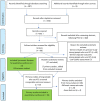Psychosocial Interventions for Amphetamine Type Stimulant Use Disorder: An Overview of Systematic Reviews
- PMID: 34220557
- PMCID: PMC8245759
- DOI: 10.3389/fpsyt.2021.512076
Psychosocial Interventions for Amphetamine Type Stimulant Use Disorder: An Overview of Systematic Reviews
Abstract
Introduction: Amphetamine-type stimulants (ATS) use is a global concern due to increased usage and the harm to physical, mental, and social well-being. The objective of this overview of systematic reviews is to summarise trial results of psychosocial interventions and describe their efficacy and safety. Methods: We searched seven bibliographic databases to November 2020 for systematic reviews examining ATS misuse treatment by psychosocial interventions. Given the apparent incompleteness of the included reviews, we undertook a supplemental meta-analysis of all eligible primary studies. Results: We included 11 systematic reviews of moderate to high quality and 39 primary studies which assessed the outcomes of psychosocial interventions on people who use ATS. The key findings include: (1) There were conflicting results about the effectiveness of psychosocial interventions among reviews, which may confuse decision-makers in selecting treatment. (2) In the supplemental meta-analysis, relative to usual care (only counselling or self-help materials), membership of a psychological intervention group was associated with an important reduction in drug usage [risk ratio (RR) 0.80, 95% CI: 0.75 to 0.85]. Patients in psychological interventions used injectables substantially less [odds ratio (OR) 0.35, 95% CI: 0.24 to 0.49]. The risk of unsafe sex in the psychosocial intervention group was lower than in the control group (RR 0.49, 95% CI: 0.34 to 0.71). The combination of therapies reduced 1.51 day using drugs in the preceding 30 days (95% CI: -2.36 to -0.67) compared to cognitive behavioural therapy intervention alone. (3) Compared to usual care, cognitive behavioural therapy was less likely to be retained at follow-up (RR 0.89, 95% CI: 0.82 to 0.97; high-quality evidence). However, the additional of contingency management strategy can make an important improvement upon retention (RR 1.42, 95%CI: 1.25 to 1.62). Authors' Conclusions: Integrated models are more effective than a single-treatment strategy. Comprehensive and sustained psychosocial interventions can help to reduce use of ATS and other drugs, risk behaviours and mental disorders, and significantly improve treatment adherence.
Keywords: amphetamine type stimulants; cognitive behavioural therapy; contingency management; drug addiction; injection drug; meta-analysis; psychosocial intervention; synthetic drug.
Copyright © 2021 Tran, Luong, Le Minh, Dunne and Baker.
Conflict of interest statement
The authors declare that the research was conducted in the absence of any commercial or financial relationships that could be construed as a potential conflict of interest.
Figures








Similar articles
-
Psychosocial interventions for psychostimulant misuse.Cochrane Database Syst Rev. 2016 Sep 29;9(9):CD011866. doi: 10.1002/14651858.CD011866.pub2. Cochrane Database Syst Rev. 2016. Update in: Cochrane Database Syst Rev. 2024 Feb 15;2:CD011866. doi: 10.1002/14651858.CD011866.pub3. PMID: 27684277 Free PMC article. Updated. Review.
-
Psychosocial interventions for preventing and treating depression in dialysis patients.Cochrane Database Syst Rev. 2019 Dec 2;12(12):CD004542. doi: 10.1002/14651858.CD004542.pub3. Cochrane Database Syst Rev. 2019. PMID: 31789430 Free PMC article.
-
Behavioural modification interventions for medically unexplained symptoms in primary care: systematic reviews and economic evaluation.Health Technol Assess. 2020 Sep;24(46):1-490. doi: 10.3310/hta24460. Health Technol Assess. 2020. PMID: 32975190 Free PMC article.
-
Psychosocial interventions for people with both severe mental illness and substance misuse.Cochrane Database Syst Rev. 2019 Dec 12;12(12):CD001088. doi: 10.1002/14651858.CD001088.pub4. Cochrane Database Syst Rev. 2019. PMID: 31829430 Free PMC article.
-
Psychosocial and pharmacologic interventions to reduce harmful alcohol use in low- and middle-income countries.Cochrane Database Syst Rev. 2023 May 9;5(5):CD013350. doi: 10.1002/14651858.CD013350.pub2. Cochrane Database Syst Rev. 2023. PMID: 37158538 Free PMC article. Review.
Cited by
-
Global burden of disease due to opioid, amphetamine, cocaine, and cannabis use disorders, 1990-2021: a systematic analysis for the Global Burden of Disease Study 2021.PLoS One. 2025 Aug 21;20(8):e0328276. doi: 10.1371/journal.pone.0328276. eCollection 2025. PLoS One. 2025. PMID: 40839682 Free PMC article.
-
Assessment of a psychiatric intervention at community level for people who inject drugs in a low-middle income country: the DRIVE-Mind cohort study in Hai Phong, Viet Nam.Lancet Reg Health West Pac. 2021 Dec 13;18:100337. doi: 10.1016/j.lanwpc.2021.100337. eCollection 2022 Jan. Lancet Reg Health West Pac. 2021. PMID: 35024661 Free PMC article.
-
Methamphetamine dependence in Australia-why is 'ice' (crystal meth) so addictive?Psychiatr Psychol Law. 2023 Jul 4;31(4):671-704. doi: 10.1080/13218719.2023.2206870. eCollection 2024. Psychiatr Psychol Law. 2023. PMID: 39118784 Free PMC article.
-
Recent Increase in Methamphetamine Use in a Cohort of Rural People Who Use Drugs: Further Evidence for the Emergence of Twin Epidemics.Front Psychiatry. 2022 Jan 7;12:805002. doi: 10.3389/fpsyt.2021.805002. eCollection 2021. Front Psychiatry. 2022. PMID: 35069295 Free PMC article.
-
Feasibility, acceptability, and perceived usefulness of a community-evidence-based harm reduction intervention for sexualized stimulant use among Mexican gay, bisexual, and other men who have sex with men.Harm Reduct J. 2024 May 16;21(1):95. doi: 10.1186/s12954-024-01020-y. Harm Reduct J. 2024. PMID: 38755623 Free PMC article.
References
-
- United Nations Office on Drugs and Crime . World drug report 2016. Pakistan Gulf Econ. (2016) 35:78–80. 10.18356/603a2a94-en - DOI
-
- United Nations Office on Drugs and Crime . Methamphetamine Continues to Dominate Synthetic Drug Markets (2018). Retrieved from: https://www.unodc.org/documents/scientific/Global_Smart_Update_20_web.pdf
-
- United Nations Office on Drugs and Crimes . World Drug Report 2020 - Booklet 2 (2020). Retrieved from: https://wdr.unodc.org/wdr2020/field/WDR20_Booklet_2.pdf
-
- United Nations Office on Drugs and Crime . World Drug Report 2020 Booklet 4-Cross-cutting issues: Evolving trends and new challenges (Vienna: ). (2020).
-
- United Nations Office on Drugs and Crime . World Drug Report 2020, Booklet 3: Drug Supply (2020). Retrieved from: https://wdr.unodc.org/wdr2020/en/drug-supply.html
Publication types
LinkOut - more resources
Full Text Sources

